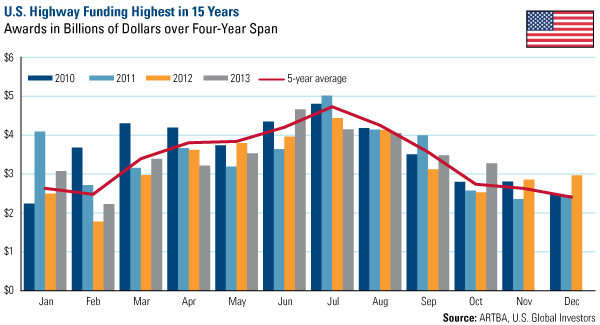Energy and Natural Resources Market Radar (November 25, 2013)
Strengths
- October U.S. highway awards were the highest in 15 years, gaining 29.2 percent over last year after increasing 11.5 percent in September. On a trailing 12-month basis, awards were up 8.6 percent year-over-year (the strongest trailing 12-month increase since July 2010). The broad 12-month trend has now been positive for nine months in a row. Year-to-date awards are up 6.7 percent year-over-year.
- The energy merger and acquisition market sizzled this week when Devon Energy announced it would buy private company GeoSouthern Energy in a $6.3 billion deal that will accelerate the U.S. group’s shift away from gas and into more lucrative oil production. The purchase will give Devon significant exposure to the Eagle Ford shale formation in south Texas, one of the heartlands of the U.S. oil boom of the past four years.
- World Steel data show October steel production up 6.4 percent year-over-year. World Steel data released this morning show October steel production of 134.3 million tons, up 6.4 percent from last October’s 126.1 million tons. Sequentially, the daily production rate of 4.3 million tons declined 2 percent from September’s 4.4 million tons per day figure. Once again, the year-over-year growth was primarily driven by China, which was up 10.1 percent year-over-year, but came in 0.5 percent lower on a sequential basis. World Steel production ex-China grew for the second month in a row, with October production of 2.23 million tons up 3.2 percent year-over-year.
- West Texas Intermediate crude rebounded this week from near its lowest closing level in five months as the dollar weakened against the euro following comments on inflation by European Central Bank President Mario Draghi. A weaker dollar typically makes oil more attractive for protecting against inflation. Prices also advanced after SkyNews Arabia reported that Saudi Arabia, the world’s largest crude exporter, said an Iraqi group claimed responsibility for launching a mortar attack on its territory Thursday.
Weaknesses
- The Federal Reserve Bank of St. Louis reported that values for quality farmland saw a decrease of 6 percent from the second-quarter average. Yet on an annual basis, quality-farmland values remain 9.1 percent higher than at the same point last year. While farmland values are still posting gains, many experts expect those double-digit jumps to soon end.
- Germany, the world’s second-largest holder of gold reserves, cut its bullion holdings in October for the second time in five months, data from the International Monetary Fund showed on Friday. Gold holdings by central banks are keenly watched since the group became net buyers in 2010 after two decades as net sellers. The 2008 global economic crisis triggered a wave of official sector interest in gold. Germany’s central bank sold 3.421 tonnes last month and now holds 3,387.247 tonnes of gold, according to the IMF website. Germany is the second largest owner of gold assets after the United States, which holds 8,133.748 tonnes of bullion after a small increase of 0.033 tonnes in October.
- The downturn in the mining sector over the past two years appears to be having a significant impact on the U.S.’s biggest mining equipment supplier, Caterpillar. The company has also been hit by a sluggish U.S. economy which has adversely affected its construction equipment business. The combination has led to plant closures worldwide and major workforce reductions. According to Equipment World, the most recent announcement of the planned shutdown of its Pulaski, Virginia coal hauler plant next year, with the loss of 240 jobs is just the latest in a string of closures – mostly related to mining equipment. In the past year, the company has announced cuts to its global workforce amounting to around 10 percent, or 13,000 jobs, in order to cut costs. The company’s third-quarter profits were 44 percent down and the company’s CEO, Doug Oberhelman, noted then that the slump in demand for mining equipment accounts for 75 percent of the expected 17 percent decline in total sales from 2012.
Opportunities
- Rio Tinto said proposed economic reforms unveiled this month by China had many positive signals, underpinning continued demand for raw materials, Bloomberg reports. The Communist Party’s third plenum document “contained many positive signals, including the pledge to further open up border areas in the interior and support land reform,” said Jan du Plessis, chairman of Rio, according to notes for a speech in Sydney. “My long-term view of the Chinese economy remains positive and we expect to see continued, robust growth in demand for commodities,” the Bloomberg report stated citing Plessis.
- The Globe and Mail reported that British Columbia Premier Christy Clark is leading a trade mission to Asia that will seek to strengthen ties with energy companies and tap into a fast-growing but crowded investment market. The British Columbia delegation traveled to Beijing where liquefied natural gas will be the focus of discussions. Other stops on the trip will include Seoul and Tokyo. A study released this month by the Asia Pacific Foundation of Canada pointed out that China invested $12 billion in Canada in 2012, placing ninth-highest in a ranking of foreign direct investment. The United States topped the list of major investor countries in Canada with $326.1 billion, or 51.5 percent of the total.
- One of Texas’ oldest oil fields, in decline for decades, has become one of the hottest places in the country to drill for crude, as energy companies create clusters of wells with layers of horizontal branches. The Permian Basin—86,000 square miles centered on Midland, Texas—has been pumping oil since the 1920s, though production peaked at about 2 million barrels a day in the early 1970s. For decades, geologists have known that oil could be found in different layers of rock piled up like a stack of geologic pancakes. But now drillers are starting to tap those layers simultaneously from a single site—and are committing billions of dollars to do so. Occidental Petroleum, the largest producer in the Permian, said it plans to spend $500 million there in 2014 and has created a new "exploitation team" to identify more drilling locations.
Threats
- Mining Weekly Australia reported that junior miners and explorers are still faced with constrained capital markets, with about 41 percent of respondents holding a cash balance of less than A$2 million. This is according to a Grant Thornton report, which also stated that 46 percent of junior miners and explorers would need to raise capital within the next six months, with more than half of the respondents expected to price their next equity-raising at a significant discount to share prices.
- The Ontario government will introduce legislation to permanently ban the use of coal for electricity generation once its last coal-fired plant stops burning the fuel in 2014, Premier Kathleen Wynne said this week. The government will introduce the Ending Coal for Cleaner Air Act in the provincial legislature the week of November 28 to ensure its commitment to end coal-fired generation by December 31, 2014, is protected by law, Wynne said in a statement. Wynne appeared with former U.S. Vice President Al Gore at a public event in Toronto to mark the closure ahead of schedule of coal-burning units at Ontario Power Generation’s Lambton and Atikokan facilities















